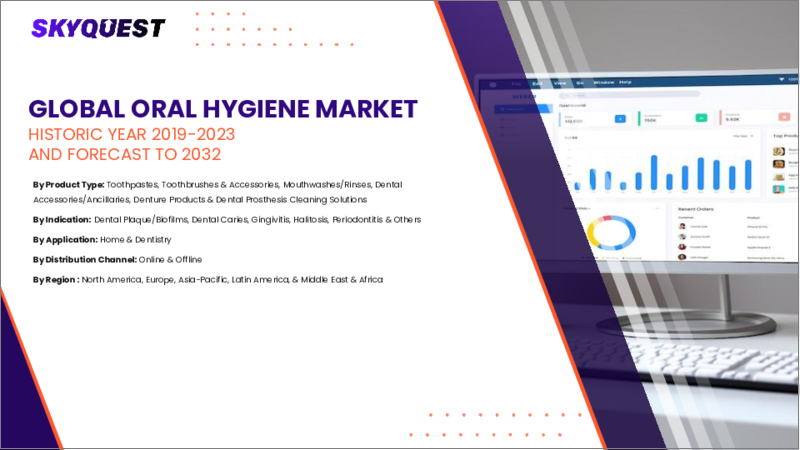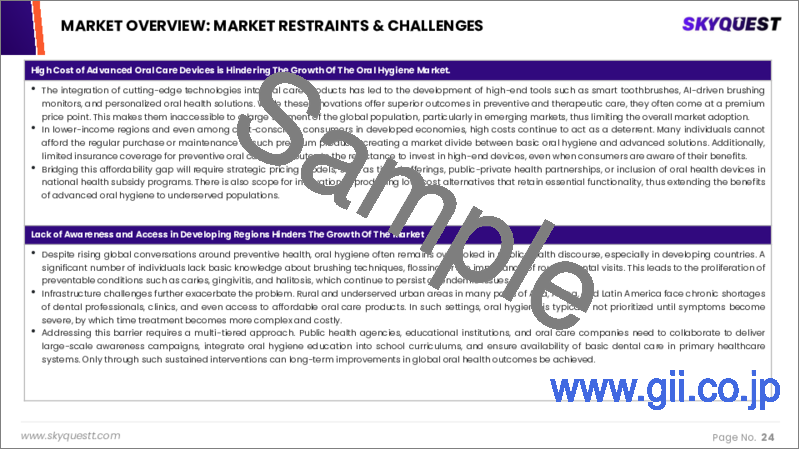|
|
市場調査レポート
商品コード
1722220
口腔衛生の市場規模、シェア、成長分析、製品別、年齢層別、流通チャネル別、地域別 - 産業予測 2025~2032年Oral Hygiene Market Size, Share, and Growth Analysis, By Product, By Age Group, By Distribution Channel, By Region, And Segment Forecast, 2025-2032 |
||||||
|
|||||||
| 口腔衛生の市場規模、シェア、成長分析、製品別、年齢層別、流通チャネル別、地域別 - 産業予測 2025~2032年 |
|
出版日: 2025年05月03日
発行: SkyQuest
ページ情報: 英文 183 Pages
納期: 3~5営業日
|
全表示
- 概要
- 目次
口腔衛生の世界市場規模は2023年に232億米ドルとなり、予測期間(2025-2032年)のCAGRは4.2%で、2024年の242億米ドルから2032年には364億米ドルに成長する見通しです。
世界の口腔衛生市場は、消費者意識の高まり、技術の進歩、人口動態の変化によって急速に進化しています。従来は歯磨き粉や歯ブラシのような基本的な製品が中心であったが、現在では電動歯ブラシ、ウォーターフロッサー、歯のホワイトニングソリューション、オーガニック口腔ケアオプションの人気により市場の多様化が進んでいます。特にZ世代とミレニアル世代における歯の審美性への関心の高まりは、理想的な笑顔を宣伝するソーシャルメディアとインフルエンサーマーケティングによって後押しされ、審美歯科製品の需要を促進しています。さらに、リアルタイムのフィードバックを提供するAI搭載のスマート歯ブラシが、既存市場でのプレミアム化を促進しています。一方、開発途上地域、特にインドと東南アジアは、可処分所得の増加と政府のイニシアチブの恩恵を受けており、多国籍企業がターゲットを絞った製品開発と流通の拡大を通じて現地での事業拡大を促しています。
目次
イントロダクション
- 調査の目的
- 調査範囲
- 定義
調査手法
- 情報調達
- 二次と一次データの方法
- 市場規模予測
- 市場の前提条件と制限
エグゼクティブサマリー
- 世界市場の見通し
- 供給と需要の動向分析
- セグメント別機会分析
市場力学と見通し
- 市場概要
- 市場規模
- 市場力学
- 促進要因と機会
- 抑制要因と課題
- ポーターの分析
主な市場の考察
- 重要成功要因
- 競合の程度
- 主な投資機会
- 市場エコシステム
- 市場の魅力指数(2024年)
- PESTEL分析
- マクロ経済指標
- バリューチェーン分析
- 規制分析
- 価格分析
- 顧客の購入基準
口腔衛生市場規模:製品別& CAGR(2025-2032)
- 市場概要
- 歯磨き粉
- ペースト
- ゲル
- 粉末
- その他
- 歯ブラシとアクセサリー
- 手動歯ブラシ
- 電動歯ブラシ
- その他
- 歯科用アクセサリー
- デンタルフロス
- 歯科用ウォータージェット
- その他
- マウスウォッシュ/リンス
- 非薬用マウスウォッシュ
- 薬用マウスウォッシュ
- 歯科製品
- 定着剤
- その他の義歯製品
- その他
口腔衛生市場規模:年齢層別& CAGR(2025-2032)
- 市場概要
- 乳幼児(0~4歳)
- 子供(5~14歳)
- 成人(15~64歳)
- 高齢者(65歳以上)
口腔衛生市場規模:流通チャネル別& CAGR(2025-2032)
- 市場概要
- オンライン
- オフライン
- 消費者向け店舗
- 小売薬局
- その他
口腔衛生市場規模:地域別& CAGR(2025-2032)
- 北米
- 米国
- カナダ
- 欧州
- ドイツ
- スペイン
- フランス
- 英国
- イタリア
- その他欧州地域
- アジア太平洋地域
- 中国
- インド
- 日本
- 韓国
- その他アジア太平洋地域
- ラテンアメリカ
- ブラジル
- その他ラテンアメリカ地域
- 中東・アフリカ
- GCC諸国
- 南アフリカ
- その他中東・アフリカ
競合情報
- 上位5社の比較
- 主要企業の市場ポジショニング(2024年)
- 主な市場企業が採用した戦略
- 最近の市場動向
- 企業の市場シェア分析(2024年)
- 主要企業の企業プロファイル
- 企業の詳細
- 製品ポートフォリオ分析
- 企業のセグメント別シェア分析
- 収益の前年比比較(2022-2024年)
主要企業プロファイル
- Colgate-Palmolive
- Procter & Gamble(P&G)
- Unilever
- GlaxoSmithKline(GSK)-Haleon
- Johnson & Johnson
- Henkel AG
- Lion Corporation
- Church & Dwight Co., Inc.
- Sunstar Group
- Dr. Fresh LLC
- Tom's of Maine
- Hello Products
結論と提言
Global Oral Hygiene Market size was valued at USD 23.2 Billion in 2023 and is poised to grow from USD 24.2 Billion in 2024 to USD 36.4 Billion by 2032, growing at a CAGR of 4.2% during the forecast period (2025-2032).
The global oral hygiene landscape is rapidly evolving, shaped by rising consumer consciousness, technological advancements, and demographic shifts. Traditionally centered on basic products like toothpaste and toothbrushes, the market is now embracing diversification with the popularity of electric toothbrushes, water flossers, teeth-whitening solutions, and organic oral care options. A heightened focus on dental aesthetics, especially among Gen Z and millennials, is driving demand for cosmetic dental products, bolstered by social media and influencer marketing promoting ideal smiles. Additionally, AI-infused smart toothbrushes offering real-time feedback are driving premiumization in established markets. Meanwhile, developing regions, particularly India and Southeast Asia, benefit from increased disposable incomes and government initiatives, prompting multinational corporations to expand locally through targeted product development and distribution growth.
Top-down and bottom-up approaches were used to estimate and validate the size of the Global Oral Hygiene market and to estimate the size of various other dependent submarkets. The research methodology used to estimate the market size includes the following details: The key players in the market were identified through secondary research, and their market shares in the respective regions were determined through primary and secondary research. This entire procedure includes the study of the annual and financial reports of the top market players and extensive interviews for key insights from industry leaders such as CEOs, VPs, directors, and marketing executives. All percentage shares split, and breakdowns were determined using secondary sources and verified through Primary sources. All possible parameters that affect the markets covered in this research study have been accounted for, viewed in extensive detail, verified through primary research, and analyzed to get the final quantitative and qualitative data.
Global Oral Hygiene Market Segments Analysis
The global Oral Hygiene market is segmented on the basis of Product, Age Group, and Distribution Channel and region. By Product, the market is segmented into Toothpastes (Pastes, Gels, Powders, Others), Toothbrushes & Accessories (Manual Toothbrushes, Electric Toothbrushes, Others), Dental Accessories/Ancillaries (Dental Flosses, Dental Water Jets, Others), Mouthwashes/Rinses (Non-medicated Mouthwashes, Medicated Mouthwashes), Dental Products (Fixatives, Other Denture Products), and Others. By Age Group, the market is segmented into Infants & Toddlers (0-4 years), Children (5-14 years), Adults (15-64 years), and Geriatric Population (65+ years). Based on Distribution Channel, the market is segmented into Online, and Offline (Consumer Stores, Retail Pharmacies, and Others). By region, the market is segmented into North America, Europe, Asia Pacific, the Middle East and Africa, and Latin America.
Driver of the Global Oral Hygiene Market
One of the key drivers of the global oral hygiene market is the heightened awareness regarding the importance of oral health. As consumers increasingly recognize the strong link between oral health and overall well-being, there is a growing trend toward the consistent practice of oral care routines. Activities such as regular brushing, flossing, and seeking professional dental check-ups are being emphasized worldwide as essential components of general health maintenance. This surge in awareness is significantly fueled by public health campaigns and educational initiatives, which are implemented at both grassroots levels and corporate wellness programs, encouraging individuals to prioritize their oral hygiene.
Restraints in the Global Oral Hygiene Market
One of the primary obstacles facing the global oral hygiene market is the increasing regulatory pressure pertaining to product safety, ingredient transparency, and environmental considerations. As consumers become more informed about ingredient safety-particularly concerning substances like fluoride, microbeads, and preservatives-companies must navigate stricter regulatory landscapes. Regulatory bodies in key markets, including the United States, European Union, and Australia, are implementing more rigorous standards for oral care products, mandating comprehensive labeling of ingredients and conducting tests for toxicity and allergens. This trend is particularly evident with fluoride, as concerns over its potential toxicity at elevated levels and environmental impact lead some countries to reassess its use in toothpaste and other products.
Market Trends of the Global Oral Hygiene Market
The Global Oral Hygiene market is witnessing a transformative trend fuelled by the rise of smart oral care products, particularly AI-driven toothbrushes like the Oral-B iO series. These advanced toothbrushes leverage artificial intelligence to monitor brushing habits, identify overlooked areas, and provide instant feedback via mobile applications. With features such as Bluetooth connectivity, pressure sensors, and interactive interfaces, these devices enhance user engagement and promote better brushing practices. This shift towards technology not only elevates the consumer experience but also heightens dental health awareness, especially among tech-savvy individuals and children, thereby revolutionizing personal dental care habits for the future.
Table of Contents
Introduction
- Objectives of the Study
- Scope of the Report
- Definitions
Research Methodology
- Information Procurement
- Secondary & Primary Data Methods
- Market Size Estimation
- Market Assumptions & Limitations
Executive Summary
- Global Market Outlook
- Supply & Demand Trend Analysis
- Segmental Opportunity Analysis
Market Dynamics & Outlook
- Market Overview
- Market Size
- Market Dynamics
- Drivers & Opportunities
- Restraints & Challenges
- Porters Analysis
- Competitive rivalry
- Threat of substitute
- Bargaining power of buyers
- Threat of new entrants
- Bargaining power of suppliers
Key Market Insights
- Key Success Factors
- Degree of Competition
- Top Investment Pockets
- Market Ecosystem
- Market Attractiveness Index, 2024
- PESTEL Analysis
- Macro-Economic Indicators
- Value Chain Analysis
- Regulatory Analysis
- Pricing Analysis
- Customer Buying Criteria
Global Oral Hygiene Market Size by Product & CAGR (2025-2032)
- Market Overview
- Toothpastes
- Pastes
- Gels
- Powders
- Others
- Toothbrushes & Accessories
- Manual Toothbrushes
- Electric Toothbrushes
- Others
- Dental Accessories/ Ancillaries
- Dental Flosses
- Dental Water Jets
- Others
- Mouthwashes/ Rinses
- Non-medicated Mouthwashes
- Medicated Mouthwashes
- Dental Products
- Fixatives
- Other Denture Products
- Others
Global Oral Hygiene Market Size by Age group & CAGR (2025-2032)
- Market Overview
- Infants & Toddlers (0-4 years)
- Children (5-14 years)
- Adults (15-64 years)
- Geriatric Population (65+ years)
Global Oral Hygiene Market Size by Distribution Channel & CAGR (2025-2032)
- Market Overview
- Online
- Offline
- Consumer Stores
- Retail Pharmacies
- Others
Global Oral Hygiene Market Size & CAGR (2025-2032)
- North America (By Product, By Age group, By Distribution Channel)
- US
- Canada
- Europe (By Product, By Age group, By Distribution Channel)
- Germany
- Spain
- France
- UK
- Italy
- Rest of Europe
- Asia Pacific (By Product, By Age group, By Distribution Channel)
- China
- India
- Japan
- South Korea
- Rest of Asia-Pacific
- Latin America (By Product, By Age group, By Distribution Channel)
- Brazil
- Rest of Latin America
- Middle East & Africa (By Product, By Age group, By Distribution Channel)
- GCC Countries
- South Africa
- Rest of Middle East & Africa
Competitive Intelligence
- Top 5 Player Comparison
- Market Positioning of Key Players, 2024
- Strategies Adopted by Key Market Players
- Recent Developments in the Market
- Company Market Share Analysis, 2024
- Company Profiles of All Key Players
- Company Details
- Product Portfolio Analysis
- Company's Segmental Share Analysis
- Revenue Y-O-Y Comparison (2022-2024)
Key Company Profiles
- Colgate-Palmolive
- Company Overview
- Business Segment Overview
- Financial Updates
- Key Developments
- Procter & Gamble (P&G)
- Company Overview
- Business Segment Overview
- Financial Updates
- Key Developments
- Unilever
- Company Overview
- Business Segment Overview
- Financial Updates
- Key Developments
- GlaxoSmithKline (GSK) - Haleon
- Company Overview
- Business Segment Overview
- Financial Updates
- Key Developments
- Johnson & Johnson
- Company Overview
- Business Segment Overview
- Financial Updates
- Key Developments
- Henkel AG
- Company Overview
- Business Segment Overview
- Financial Updates
- Key Developments
- Lion Corporation
- Company Overview
- Business Segment Overview
- Financial Updates
- Key Developments
- Church & Dwight Co., Inc.
- Company Overview
- Business Segment Overview
- Financial Updates
- Key Developments
- Sunstar Group
- Company Overview
- Business Segment Overview
- Financial Updates
- Key Developments
- Dr. Fresh LLC
- Company Overview
- Business Segment Overview
- Financial Updates
- Key Developments
- Tom's of Maine
- Company Overview
- Business Segment Overview
- Financial Updates
- Key Developments
- Hello Products
- Company Overview
- Business Segment Overview
- Financial Updates
- Key Developments






